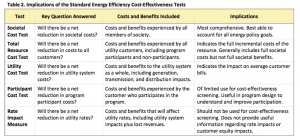 Since the end of the General Assembly session back in March 2018, there have been quite a few updates on utility energy efficiency programs. Some of you may have attended our spring breakout session on utility programs.
Since the end of the General Assembly session back in March 2018, there have been quite a few updates on utility energy efficiency programs. Some of you may have attended our spring breakout session on utility programs.
VAEEC members can get a deeper dive into these updates by visiting our Member Resources page. From there, you can read all of our blog posts during the session, in case you missed them the first time and can scan a newly-updated presentation we created just for members.
If you have trouble accessing the Member Resources page, please contact our Program Coordinator, Jessica Greene Jessica@vaeec.org.
If you are not a member but would like to receive this same, in-depth information, we hope you will consider joining today.

VAEEC member Charlottesville is encouraging local businesses to participate in the Charlottesville Better Buisness Challenge, being offered this year by the Charlottesville Climate Collaborative. Started by a partnership with Better World Betty and LEAP (the Local Energy Alliance Program- a VAEEC Associate Member) in 2010, the Challenge has provided Charlottesville organizations with a way to participate in a friendly competition while cutting energy costs and leaving a positive impact on their community. From local schools and businesses such as Albemarle Baking Company to national, larger brands like Whole Foods and Plow and Hearth, the Better Business Challenge is fit to serve organizations of all sizes.
This Challenge is open to veterans of the green business game as well as people who may just be warming up to the idea. It provides an entry point to a fast-growing network of businesses who not only care about their bottom line but also their community impact. Last round’s 78 participants saved an average of $185,000 per year while taking 4,270 cars off the road, reducing CO2 by 1,823 tons!
So, why do businesses join? Business leaders across the nation have begun to realize that when you optimize energy use and transition to renewable energy, it just makes good business sense. For example, Plow and Hearth saved over $93,000/year in electricity bills with a lighting overhaul and Virginia Eagle Distributing saved $33,000 annually after instituting recycling and installing solar panels on tractor trailers.
The Challenge is easy and flexible to suit the busy schedule of companies and businesses. Every player is equipped with the tools necessary to cut costs and increase their bottom line. Participation grants access:
- to an Energy Scorecard with 46 action items to help reduce and improve energy use
- an Energy Catalyst Toolkit which is an easy-to-use digital toolkit to tailor the solution to your business needs
- catered “Lunch n’ Learns” that highlight key topics to stay ahead of the curve
- a challenge coach who works with your schedule to get things done, and
- an energy walkthrough to uncover further opportunities to save.
In addition, during the last Challenge, there were 35+ positive publicity outreaches to potential customers, members, and supporters. Participant businesses also received 850,000 local audiences “touches” through social media and other channels about their actions for becoming more green.
Any business, non-profit, or church located in Fluvanna, Louisa, Albemarle, Augusta, Nelson, and Greene County may register and participate in the Challenge. Click here to find out more about how to get started in the Better Business Challenge.
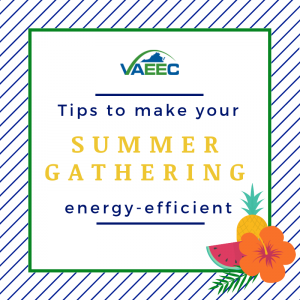 Pool parties, cookouts, and other home gatherings will begin to pop up on your calendar as the weather rises into the summer. Whether it be for Father’s Day, a graduation party, Independence Day, or just a summer cookout, practicing energy-efficient steps can still help you save on your bills. Here are some tips on how to make your next gathering more energy-efficient:
Pool parties, cookouts, and other home gatherings will begin to pop up on your calendar as the weather rises into the summer. Whether it be for Father’s Day, a graduation party, Independence Day, or just a summer cookout, practicing energy-efficient steps can still help you save on your bills. Here are some tips on how to make your next gathering more energy-efficient:
Plan Ride-Share/Carpool Groups
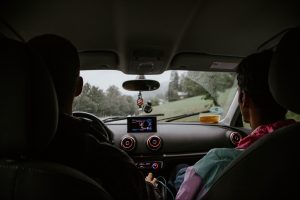
Planning out carpools can save gas money for everyone involved. Have guests that live relatively close to one another either choose a designated driver or split a ride with businesses like Lyft or Uber.
Sharing rides cuts down on overall traffic on the road as well. Researchers at MIT developed an algorithm that found 3,000 sedans would be able to take care of almost all taxi demand in New York City, “with an average wait time of only 2.7 minutes.”
Use Fans to Cool the Room
Ceiling fans and portable fans are an easy way to keep cold air circulating in your room and save money on energy. While fans don’t actually cool the air, moving air evaporates moisture from the skin at a faster rate than normal, cooling the body. This is known as the wind-chill effect.
Using the AC in conjunction with the fan can save you money while maintaining the same level of comfort. Increasing the thermostat 2° F during the summer while using the fan to better circulate the air can result in a 15% reduction in air conditioning energy use.
Plan Parties for the Evening

Avoid the daytime heat surges by opting for an evening gathering instead. As temperatures cool, air conditioning won’t have to work as hard to reach your optimal setting. When weather permits it, you can open windows to cool the house and turn off the thermostat altogether and use the wind-chill effect from the breeze and/or fan.
Remember to turn off the air when you open the windows; many people forget to turn off the AC when the windows are open, which actually wastes more energy.
Plan Refreshments Efficiently

If you are planning to prepare food for your gathering, look into how you can save energy using alternative techniques.
- Use the correct eye size for the pot when you’re cooking on the stovetop. Using an 8-inch burner on a 6-inch pan wastes over 40% of heat energy to the air.
- Covering a pot when boiling water will cut the wait time, and energy use, in half.
- Instead of having guests constantly opening the refrigerator to grab drinks, pack them in a cooler or other container filled with ice. This will keep the internal temperature and humidity of the fridge consistent and prevent it from working overtime.
As mentioned at our Spring 2018 Meeting, the final Uniform Statewide Building Code (USBC) was published in the Virginia Register on April 30th. There is currently a 30-day public comment period open for any citizen who has concerns regarding these regulations.
If you have been following this process, then you will recall that VAEEC, in concert with our members and partners, was successfully able to work with home builders and code officials to include more energy efficiency measures in this new USBC update.

Initially, we anticipated the final regulations back in December with an effective date of July 1, 2018. Unfortunately, there was a major delay, which has now pushed the effective date to September 4th for the USBC and October 16th for the Fire Prevention Code. Earlier this week, we learned that this will most likely cause a delay for the next cycle update. It does not look like there is an appetite to start the next update cycle in 2019, as originally planned.
We will keep you posted as we learn more.
On May 10th, we held our Spring Meeting at the University of Richmond Jepson Alumni Center. A huge thank you to our sponsors for making our event possible, and a thank you to all those who attended and made it a success!
Registration and networking kicked off our meeting at 10:00a.m. As attendees filed in, we started our opening presentation and business meeting portion of our agenda. Chelsea Harnish, our Executive Director, gave a recap of some of the accomplishments and updates VAEEC’s had in the past year. Some of these updates included highlights from our Annual Report, which can be viewed here.
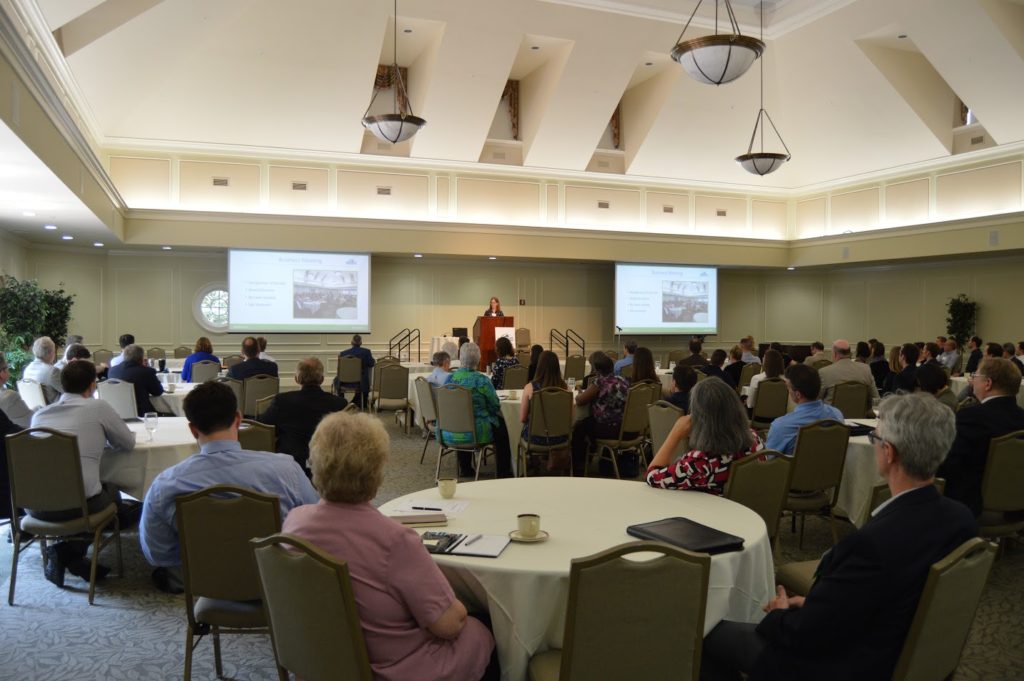
Chelsea Harnish presents the opening remarks.
Key 2017 Updates:
- 1 New Board Member
- 1 Publication, “Why Energy Efficiency is a Smart Investment for Virginia”
- 5 Videos Produced
- 4 Webinars Hosted
- 6 Sponsored Events
- 2 In-District Site Visits with Legislators
- 18 Award Winners at 2nd Annual Virginia Energy Efficiency Leadership Awards Ceremony
- 125+ Attendees at Awards Ceremony
- Membership grew nearly 25%
After Chelsea’s updates, members voted on three Board Members up for reelection: Richard Caperton–Oracle, John Morrill–Arlington County, and David Koogler–Rappahannock Electric Coop. Members also voted on one new Board Candidate, Michael Hubbard–Dominion Energy, to replace former Board Member Tom Jewell. Each passed unanimously.
Following the Board election, we had our Remarkable Member Updates and Membership Poll. For our membership poll we tried something new, and included a question for non-member attendees. We used PollEverywhere to collect real time responses from the audience, displaying answers on the screen. We asked these questions:
- Currently, the VAEEC is focused on commercial PACE and residential building codes and utility programs. What additional topics would you like the VAEEC to focus on or address during 2018?
- Would a job opening and resume board posted on the VAEEC’s Members Resources page be beneficial to you or your organization?
- What additional benefits would you like included in your VAEEC membership?
- For Non-Members: What is preventing you from joining VAEEC?
One of our most memorable responses to our additional benefits questions was “more happy hours.” While we’re not sure we can deliver on “the happiest hour ever”, we appreciate everyone who participated and gave us valuable feedback to work with moving forward. In fact, the overwhelming positive response to the idea of a job board led us to immediately add one in our Member Resources Page.
Our group then broke up for breakout sessions. Attendees could choose between a Residential Utility Programs panel or a panel on Commercial Building Automation. The Residential Utility Program panel was held in the Quigg Room with Michael Hubbard (Dominion Energy) and Zack Bacon (Appalachian Power Co.) as speakers and Chelsea Harnish as Moderator. The second panel was held in the main room on Commercial Building Automation, with speakers Philip Agee (Viridiant), Cindy Zork (USGBC), George Holcombe (Capital One), Amanda Jenkins (Johnson Controls) and Jessica Greene as Moderator. Both panels hit a snag in the middle as the fire alarm went off and the building was evacuated.
The panel on Residential Utility Programs gave quick updates on both Dominion Energy and ApCo’s programs proposed to the State Corporation Committee. At the time, these plans were still under consideration however just a few days after the meeting, the SCC released their final order on ApCo’s programs. Three of their residential programs were approved and one was denied. All of the commercial programs were approved. Dominion Energy’s Low-Income Program was approved May 15, though with a reduced budget and at a three-year timeframe instead of the proposed five-year program.
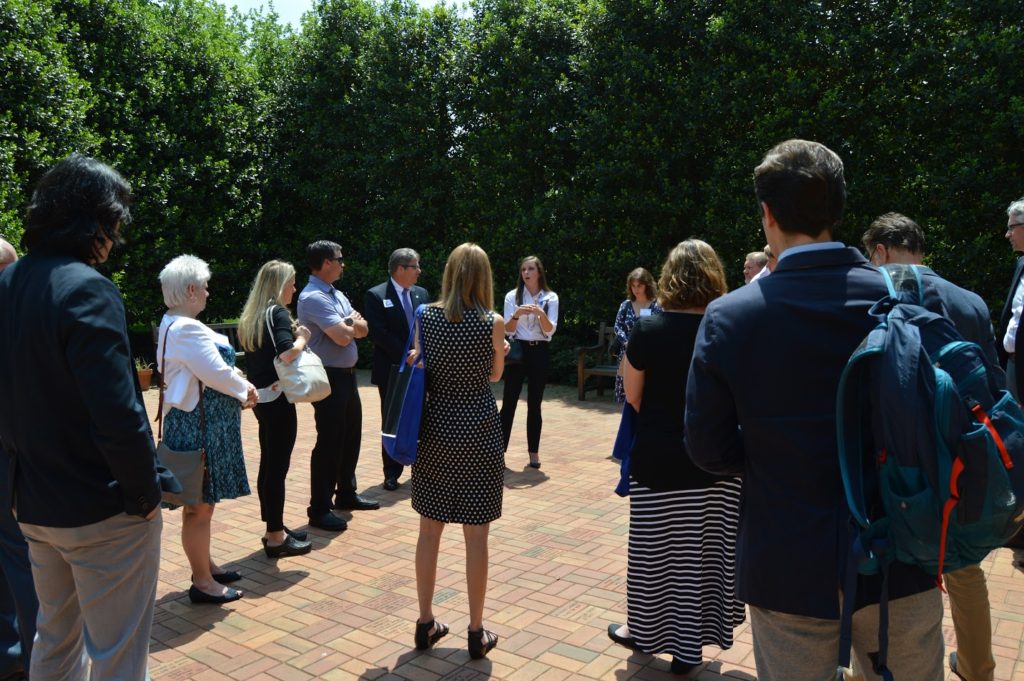
The Commercial Building Automation breakout session holds their Q&A in the courtyard.
The Commercial Building Automation panel discussed how implementing building automation can save money, consume less energy, use less water, use fewer resources and provide better indoor environmental quality. These benefits are also the categories that buildings are scored with on how effective their automation is. While the fire alarm was disruptive, for the Commercial Building Automation panel, it provided a chance for attendees and panelists to interact in a more informal setting and they held their Q&A portion outside in a courtyard.
After the breakout sessions, we took a quick lunch break before listening to our Keynote Speaker Angela Navarro, the Deputy Secretary of Commerce and Trade. Angela talked about Governor Ralph Northam’s various energy efficiency policies and his priorities moving forward.
For our final portion of the meeting, we asked our attendees to break into four groups based on the topic that most interested them. The choices were: Commercial-PACE, Local Government, Residential EE and Utility Programs. We had attendees participate in discussions about the challenges each of these sectors are facing and what solutions we can implement to overcome them. After discussion, each group presented a short summary of what they talked about to the rest of the attendees. The notes for the Interactive Session can be found here.
While certainly not perfect (considering our fire alarm disruption) we’re still thrilled we were able to try new things with positive reviews from our attendees. Participation in our membership poll was the highest we’ve had to date, and the feedback on the Interactive Session from our post-event survey shows attendees found it was not only useful but enjoyable; meaning it’s sure to stay for future events. Again, thank you to all in attendance for making the 2018 Spring Meeting a success!
Presentations can be viewed below:
If you’d like to view photos from the event check out our album. Feel free to use them on your own social media!
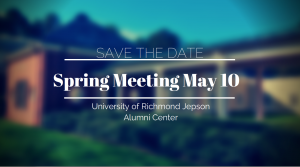
May is quickly approaching and we cannot wait to see all of you at our Annual Spring Meeting in just a few short weeks!
The meeting will be held at the University of Richmond in the Jepson Alumni Center on May 10th from 10:30 to 2:30. Arrive at 10:00 am to get in some extra networking before the meeting begins. Once you get settled in, help make VAEEC the best that it can be by participating in our 2018 Board Elections and, for the first time, a live membership poll that will be conducted via text message! The poll will consist of no more than five questions with multiple choice and write-in answers. Let VAEEC know how we can better serve you!
Our breakout sessions this year will focus on Commercial Building Automation and Residential Utility Programs. The commercial panel will offer participants a chance to interact with panelists to learn more about commercial building automation and to overcome existing challenges with their building automation systems.
Staff from Dominion Energy and Appalachian Power Company will be on the utility panel to discuss how they plan to turn their commitments to energy efficiency- in the new utility spending bill that the Governor signed into law last month- into reality. Join either group to brainstorm how energy efficiency can grow even further in Virginia.
During lunch, we will be joined by the Secretary or Deputy Secretary of Natural Resources to lay out the Governor’s vision and priorities for energy efficiency over the next four years. This will be a great opportunity for us to connect with the new administration on our work.
Our final panel of the day will be a fun, interactive session that provides you with the opportunity to shape VAEEC’s work for the remainder of the year. After a brief overview, attendees will join one of four breakout groups to discuss a variety of issues: Residential programs, Local Government activities, Utility Program expansion or Commercial PACE. We can’t wait to see what you all come up with.
One of the many benefits of being a member of VAEEC is having your chance to shine! Share your success story during the Member Share portion of our event. Email Jenn Fisher, our new Administrative Assistant, at info@vaeec.org to sign up in advance. New this year, we are also providing our members with the opportunity to leave out their business cards and marketing materials on our Member Networking table. In order to accommodate all materials, we are asking our members to email your information to info@vaeec.org by May 7th at 5pm.
 If you are not yet a member but want to take advantage of this and the other great benefits that come with a VAEEC membership, the week of the Spring Meeting is the best week to join! Join at any membership level above Individual between May 7th and May 10th, and your name will be entered to win a $25 Amazon gift card!
If you are not yet a member but want to take advantage of this and the other great benefits that come with a VAEEC membership, the week of the Spring Meeting is the best week to join! Join at any membership level above Individual between May 7th and May 10th, and your name will be entered to win a $25 Amazon gift card!
Hurry up and register today! Registration closes next Monday, April 30th. For members, media, or speakers please use this link to register. If you are not yet a member of VAEEC, please register here. We look forward to seeing you on May 10th!
Happy (Almost) Earth Day Everyone!
Since 1970, April 22 has become a globally recognized day of action and education. Earth Day events are coordinated in over 192 countries and bring people together to celebrate the amazing world around us and recognize the worth in protecting it. Our planet is remarkable and there’s much we can learn from it. In fact, there’s a scientific discipline dedicated to studying and copying nature–biomimicry.

Biomimicry aims to learn from nature to engineer the future. The discipline looks to solve problems faced by humans by observing how organisms and natural systems deal with the very same issues. Reducing energy use is one problem scientists and engineers are tackling by looking at the world around them to inspire solutions.
Here are four examples of energy efficiency through biomimicry:
In the U.S. alone in 2016, 40% of total energy consumption came from the commercial and residential sectors, primarily from buildings. Buildings suck energy in their heating and cooling systems. Even energy efficient buildings with blinds and shades designed to conserve energy use plug-in electricity and batteries. Cones produced from trees like pines, spruce, hemlock, and fir respond naturally to humidity and moisture to open, using minimal energy in the process. Cordt Zollfrank, a chemist, forest scientist and materials researcher at the Technical University of Munich (TUM), is working to design buildings that would respond similarly. The concept could be used wherever buildings experience humidity changes, such as in climate control units.
Humpback whales are the largest animal on the planet, yet they maneuver through the water fast enough to chase fish. Not only are humpbacks quick enough to chase down a meal, but they have to make tight turns as well. Humpbacks are able to make tight maneuvers by putting their flippers at sharp angles of attack. Angle of attack in fluid dynamics is the angle between a reference line representing a body moving and the vector line representing the motion between the body and the fluid through which it is moving. Angles of attack and lift are closely linked, so raising the angle of attack increases lift as well. This movement is helped by tubercles, which create scalloped edges on the leading side of their flippers. This gives them more lift to turn. Professor Frank Fish at West Chester University studied tubercles and the scallop shape and found that tubercles increased the angle of attack up to 42 percent. Engineers have begun to add tubercles and scalloped blades on wind turbines, creating a higher angle, enabling more lift and increasing efficiency.
Equipment in buildings usually function independently and in isolation of one another. They are set on a single thermostat or timer that doesn’t have the capability of knowing what else is currently operating in the building. Since equipment doesn’t communicate with one another they often run at the same time, wasting energy. The clean technology company Encycle created Swarm Logic which can cut a property owner’s electric costs 5-10% or more a year. The technology is based on the way bees and other social insects communicate and coordinate with one another. The controllers establish a wireless network among power-consuming appliances and this enables them to communicate among themselves autonomously. Once the communication network is set then an algorithm is created so the connected appliances spread out their energy demand.
Boeing and NASA have teamed up to find ways for major airlines to save jet fuel. The answer they came up with? Copy geese. By lining up cruising airplanes in a V-formation like migrating geese, the planes leap in efficiency without investing in new technology or changing the designs of individual planes. The concept is called wake surfing. It involves harvesting energy from a lead plane by cutting down on the drag and wind resistance from the planes (or birds) following the leader. The method is still in the works but has the potential to cut down fuel bills and make air travel more energy efficient.
Nature has already solved many of the problems we face today. Animals, plants, microbes, and systems have undergone billions of years or trial and error. These biomimicry breakthroughs in energy efficiency are just a few of the ways emulating nature is shaping the future of sustainable innovation.
The VAEEC has been focused on advancing Commercial Property Assessed Clean Energy, or C-PACE, financing across the Commonwealth for the past few years. Since Virginia’s C-PACE law requires interested localities to develop and implement their own C-PACE program, start up can be on the slow side. However, we’ve seen a lot more traction lately thanks in part to the launch of Virginia’s first C-PACE program (in Arlington County) and the recent release of C-PACE resources for local governments.
Program Status in Virginia
Over 30 states and Washington, D.C. have approved C-PACE programs. Virginia joined this growing list in 2009 when it first passed C-PACE enabling legislation, which was later amended in 2015. Our C-PACE law includes all new and existing commercial, industrial, multifamily residential (over four units), and nonprofit buildings.
Arlington County’s C-PACE program officially launched in January of this year with the goal of improving new and existing buildings and helping the County’s Community Energy Plan implementation. Sustainable Real Estate Solutions, or SRS, was selected as their independent, third party program administrator to provide marketing, outreach, education, and quality assurance services.
During a January 2018 Board meeting, the Loudoun County Board of Supervisors unanimously voted to direct staff to develop a C-PACE program structure, evaluate options for Program Administration, and draft an ordinance. These items will be brought back to the Board at a future meeting for consideration. Similarly, Fairfax County is exploring the development of a C-PACE program. County staff are developing information for the Environmental Committee with the goal of presenting their findings to the Committee at their next meeting on June 12th.
In addition to providing educational information to Loudoun and Fairfax, the VAEEC is working with several other jurisdictions to answer questions and help with program development. Just last week, we worked with the City of Virginia Beach to organize a C-PACE informational session for all municipal staff in the Hampton Roads region. Representatives from the Cities of Norfolk, Portsmouth, and Virginia Beach were in attendance. We are also working with local Virginia chapters of the Sierra Club to host a C-PACE event on May 30th in the City of Alexandria. This event will be open to all C-PACE stakeholders in the area, including property owners, contractors, lenders, and municipal staff. We also continue to work with the City of Charlottesville and Albemarle County to answer staff questions and provide guidance on the resources currently available to localities.
Resources for Local Governments
In early 2018, the VAEEC released a Virginia model ordinance for localities to use when crafting their own program. The ordinance was commissioned following a review and input from a wide variety of C-PACE experts in the lending, local government, engineering, legal, and policy fields. This document incorporated key factors that we consider to be crucial to implementing an effective C-PACE program.
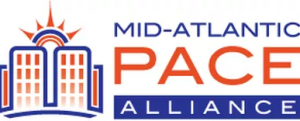
Accelerating C-PACE throughout DC, MD, & VA
As part of its mission to accelerate the development and utilization of C-PACE in the Mid-Atlantic region, MAPA is currently creating program implementation guidance. These regional guidelines will be a part of a toolkit created to help localities craft their own C-PACE program and is slated to be released by June. In conjunction with MAPA, the VAEEC will be hosting a C-PACE webinar in September that will walk attendees through both this toolkit and the Virginia model ordinance.
Virginia localities may review the program infrastructure implemented in Arlington County, including the County ordinance and other program documents. There is also the option to “ride” the C-PACE Program Administration contract with SRS, which would eliminate the need for a Request for Proposals (RFP) process and shortens the time to program launch. Localities may also contract directly with SRS if cooperative procurement is not preferred. Explore the Arlington C-PACE website for more information.
The VAEEC prides itself on being a neutral, trusted resource for any Virginia localities interested in C-PACE. We are actively meeting with local governments across Virginia to discuss all available options and help each locality determine which option best suits their needs. If you would like to know more about C-PACE, contact Jessica Greene at jessica@vaeec.org.
The public hearings for the Carbon Trading Rule and Clean Energy Virginia Initiative have wrapped up, but there is still time to submit public comments before the April 9th deadline. VAEEC encourages members to submit comments supporting the energy efficiency carve out and are happy to help you draft comments.
VAEEC Comments
Click here to view VAEEC’s public comments.
Background
Last November, the Virginia Air Pollution Control Board approved Governor McAuliffe’s regulations to limit carbon emissions from Virginia’s electric generating facilities. These regulations will:
- cap emissions at 33 or 34 million tons
- reduce carbon emissions 30% between 2020-2030
The state will hold quarterly consignment auctions to determine the cost of the allowances and the money from that auction will be given back to the utilities (not to state), which is a first of its kind in the US.
Five percent of the allowances will be withheld from the consignment auction and will be transferred to the Department of Mines, Minerals and Energy (DMME) to implement energy efficiency programs. DMME plans to hold a separate rulemaking for this piece of the carbon rule later this year. VAEEC will continue providing resources to DMME as they investigate options for program design and implementation.
There is currently an open comment period through April 9th, 2018.
Passage of the Grid Transformation and Security Act of 2018 underscores the widespread, bipartisan agreement that energy efficiency is a smart investment for the Commonwealth. The VAEEC endorsed this legislation because of the tremendous potential opportunities for energy-saving programs that will be provided to Virginians over the next decade, including a combined commitment by the electric utilities to spend over $1.3 billion on energy efficiency programs. Unfortunately, all of that potential could easily evaporate away.
Last month, the State Corporation Commission (SCC) held proceedings to review proposed energy efficiency programs for both Appalachian Power Company (APCO) and Dominion Energy. Dominion Energy filed for approval to extend their low-income program for another five years. As defined by Virginia law, low-income programs are already determined to be in the public interest so these types of programs do not face as much scrutiny by the SCC.
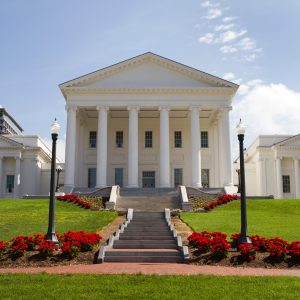 During the APCO proceeding however, the SCC staff recommended rejecting all five of the utility’s proposed residential programs. For three of these programs, the SCC staff stated that the utility had not taken into account new federal lighting standards taking effect in 2020. APCO decided to withdraw one of the programs for consideration due to this change but argued in their rebuttal testimony that the SCC staff’s interpretation of the new standard was incorrect for the other two programs since they would be direct install measures. Meaning, the program contractors would directly install the new LED light bulbs into sockets where incandescent light bulbs currently exist and would not be replacing CFL light bulbs with LEDs, as stated in the SCC staff response.
During the APCO proceeding however, the SCC staff recommended rejecting all five of the utility’s proposed residential programs. For three of these programs, the SCC staff stated that the utility had not taken into account new federal lighting standards taking effect in 2020. APCO decided to withdraw one of the programs for consideration due to this change but argued in their rebuttal testimony that the SCC staff’s interpretation of the new standard was incorrect for the other two programs since they would be direct install measures. Meaning, the program contractors would directly install the new LED light bulbs into sockets where incandescent light bulbs currently exist and would not be replacing CFL light bulbs with LEDs, as stated in the SCC staff response.
Similarly concerning was the SCC staff’s re-calculation of the cost-benefit tests for APCO’s appliance recycling program renewal, which incentivizes customers in their territory to recycle secondary appliances such as refrigerators. The SCC staff stated that the company miscalculated the cost-benefit tests of this program and performed new calculations, causing the program to fail two of the four cost-benefit tests.
According to experts I’ve spoken with, these new test results calculated by the SCC staff for the appliance recycling program are questionable since there is no customer cost for this particular program, therefore, it is unclear how this program could fail the Total Resource Cost Test but not the Utility Cost Test. Below is a table that was produced in a 2014 VAEEC report explaining the purpose of all four tests.
You may be wondering what this means, especially since this is all pretty technical, but what it boils down to is this: the substantial commitments to energy efficiency by both Dominion Energy and Appalachian Power Company in the omnibus utility bill will not come to fruition if energy efficiency programs continue to be scrutinized in this manner.
To be clear, the VAEEC supports the role that the SCC plays in scrutinizing proposals put forth by the utilities. That is their job and it is an important one. However, they tend to scrutinize energy efficiency programs more so than other proposals- including new power generating facilities. They do not view energy efficiency as a true resource when it comes to planning for future energy needs, when, in fact, it should be viewed as the critical first step. The kilowatt that goes unused is the cheapest form of energy. Allowing utilities to develop robust programs that help all customers make smart energy choices helps reduce the need for new, larger power generation facilities in the future. Energy efficiency isn’t a silver bullet by any means, but it is a valuable tool in the toolbox that should be utilized much more often than it is now.
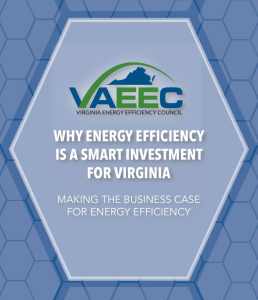
Investments in energy efficiency also mean new jobs in every corner of Virginia. In our report “Why Energy Efficiency is a Smart investment for Virginia,” we found that energy efficiency is a $1.5 billion industry in Virginia that supports approximately 75,000 jobs. Greater investments and growth in energy efficiency means more jobs in the local communities being served- jobs that cannot be outsourced out-of-state or overseas. This is the argument that we have made before the SCC over the last two years.
The SCC should evaluate the economic development and job creating benefits that these programs create in the local communities they serve. These same benefits are included in the analysis to build new fossil-fueled facilities, so why wouldn’t the same economic benefits for energy efficiency be factored in as well? Especially given that most of the jobs created by building new power plants are temporary construction jobs whereas the jobs provided by energy efficiency programs are year-round and last for the life cycle of program.
The vacant seat on the SCC provides a unique opportunity to unleash the economic potential of energy efficiency for the citizens of the Commonwealth. It is our hope that a new Commissioner is appointed soon and that he or she sees the value and tremendous opportunity that energy efficiency provides. Otherwise, we will be leaving over a billion dollars on the table.
 Since the end of the General Assembly session back in March 2018, there have been quite a few updates on utility energy efficiency programs. Some of you may have attended our spring breakout session on utility programs.
Since the end of the General Assembly session back in March 2018, there have been quite a few updates on utility energy efficiency programs. Some of you may have attended our spring breakout session on utility programs.

 Pool parties, cookouts, and other home gatherings will begin to pop up on your calendar as the weather rises into the summer. Whether it be for Father’s Day, a graduation party, Independence Day, or just a summer cookout, practicing energy-efficient steps can still help you save on your bills. Here are some tips on how to make your next gathering more energy-efficient:
Pool parties, cookouts, and other home gatherings will begin to pop up on your calendar as the weather rises into the summer. Whether it be for Father’s Day, a graduation party, Independence Day, or just a summer cookout, practicing energy-efficient steps can still help you save on your bills. Here are some tips on how to make your next gathering more energy-efficient:






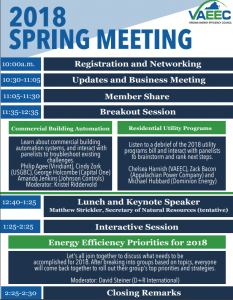
 If you are not yet a member but want to take advantage of this and the other great benefits that come with a VAEEC membership, the week of the Spring Meeting is the best week to join! Join at any membership level above Individual between May 7th and May 10th, and your name will be entered to win a $25 Amazon gift card!
If you are not yet a member but want to take advantage of this and the other great benefits that come with a VAEEC membership, the week of the Spring Meeting is the best week to join! Join at any membership level above Individual between May 7th and May 10th, and your name will be entered to win a $25 Amazon gift card! 
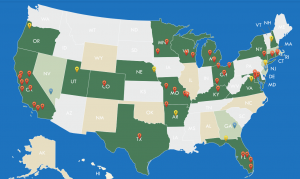

 During the APCO proceeding however,
During the APCO proceeding however, 